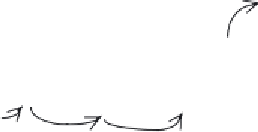Biomedical Engineering Reference
In-Depth Information
-
O
2
H O
2
O
2
NADPH oxidase
2
e
-1
Plasma
membrane
e
-1
flow
NADP
+
+H
+
22kDa
NADPH
91 kDa
Cytosol
Associated
cytosolic factors
Figure 8.8
Production of reactive oxygen species by phagocytes. In addition to degrading foreign sub-
stances via phagocytosis, phagocytes secrete reactive oxygen species into their immediate environment. This
can kill microorganisms (and indeed damage healthy tissue) in the vicinity, thus helping control the spread of
infection. The reactive oxygen species are produced by an NADPH oxidase system, the main feature of which is
a plasma membrane-based electron transport chain. NADPH represents the electron donor. The fi rst membrane
carrier is NADPH oxidase, which also requires interaction with at least two cytosolic proteins for activation.
The electrons are passed via a number of carriers, including a fl avoprotein, to cytochrome b
558
. This is a haem
protein consisting of two subunits (22 and 91 kDa). The cytochrome, in turn, passes the electrons to oxygen,
generating a superoxide anion (O
). The superoxide can be converted to hydrogen peroxide (H
2
O
2
) spontane-
ously, or enzymatically, by superoxide dismutase. A genetic defect affecting any element of this pathway will
result in a compromised ability/inability to generate reactive oxygen species, normally resulting in CGD. Over
50 per cent of CGD sufferers display a genetic defect in the 91 kDa subunit of cytochrome b
558
induces these effects is understood, at least in part. In
healthy individuals this cytokine is a potent activator of phagocytes. It potentiates their ability to
generate toxic oxidative products (via the NADPH oxidase system), which they then use to kill
infectious agents. In CGD sufferers, IFN-
The molecular basis by which IFN-
γ
boosts fl ux through the NADPH oxidative system. As
long as the genetic defect has not totally inactivated a component of the system, this promotes
increased synthesis of these oxidative substances. IFN-
γ
also promotes increased expression of
IgG F
c
receptors on the surface of phagocytes. This would increase a phagocyte's ability to destroy
opsonized infectious agents via phagocytes (Figure 8.9).
Additional molecular mechanisms must also mediate IFN-
γ
effects, as it promotes a marked
clinical improvement in some CGD patients without enhancing phagocyte activity. IFN-
γ
's d e m o n -
strated ability to stimulate aspects of cellular and humoral immunity (e.g. via T- and B-lymphocytes),
as well as NK cell activity, is most likely responsible for these observed improvements.
IFN-
γ
may also prove valuable in treating a variety of other conditions, and clinical trials for
various indications are currently underway. This cytokine shows promise in treating leishmania-
sis, a disease common in tropical and subtropical regions. The causative agent is a parasitic pro-
tozoan of the genus
Leishmania
. The disease is characterized by the presence of these protozoa
inside certain immune cells, particularly macrophages. IFN-
γ
appears to stimulate the infected
macrophage to produce nitric oxide, which is toxic for the parasite.
γ





Search WWH ::

Custom Search